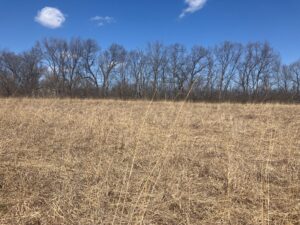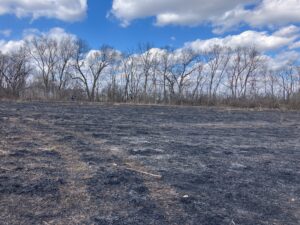By Annika Moran, Huron Pines AmeriCorps member
On March 28, 2024, a steady eastward breeze swept across the tall grasses and wildflowers of the Lloyd and Mabel Johnson Preserve. The sun shined bright overhead from an azure sky dotted with small fluffy clouds. Temperatures had been steadily climbing all morning to a high of 50 degrees Fahrenheit.
To most people, it was a beautiful day for an early-spring walk. But for PlantWise, Legacy’s prescribed fire contractor, it was also the perfect day to start a fire.
Prescribed fire is an important component of stewardship on Legacy’s preserves. Prior to European colonization, native peoples conducted prescribed fires in order to hunt and keep the landscape open. As a result of thousands of years of this stewardship, many southeast Michigan plant species are fire adapted, meaning they thrive best in landscapes where fire is a regular visitor. These species can often only be found in one of Michigan’s fire-dependent natural communities, which are entire ecosystems that can only exist with help from regular fires.
Prairies—like the one in Johnson Preserve—are one of Michigan’s rarest fire-dependent natural communities. Due in part to centuries of fire suppression by European colonizers, only 2% of southern Michigan’s original prairie habitat remains when compared to pre-colonization.1 Without fire to knock back fire-intolerant plant species, woody plants—some native to Michigan and some imported from Eurasia—make their way into former prairie habitat and shade out native grasses and wildflowers. The result is less habitat for insects and birds that rely on prairie plant species.
Through prescribed fires and other stewardship, Legacy Land Conservancy is doing its part to preserve and restore prairies in Michigan. The prairie at the Johnson Preserve was an agricultural field when Legacy acquired the property in 2007. Beginning in 2016, Legacy Land Conservancy started to convert this field into a home for native species that were historically found in this area of Michigan. Today, the Johnson prairie is dominated by native Michigan species including the towering Andropogon gerardii (big bluestem grass), the striking purple Liatris spicata (Marsh blazing star), the pollinator-favorite Monarda fistulosa (wild bergamot) and the fragrant Pycnanthemum spp. (mountain mints). Not only are these species beautiful to look at, but they provide food and habitat for the diverse pollinators, birds and mammals who make Michigan their home. [Click here to read a previous article about the restored prairie at Johnson Preserve – From Farmland to Prairie: A show worth the wait]
Legacy and PlantWise take several steps to ensure that their prescribed burns are conducted in a safe manner both for the surrounding area and for the animals who live in the preserve itself. First, weather is monitored very closely leading up to a burn, and the burn is only conducted under optimal conditions. This means dry, breezy conditions where smoke can disperse so as not to cause a health hazard and where flames can easily be kept in the burn area. Second, only a small area of the preserve is burned at one time, so that less smoke is produced and animals who live in the burn area have ample opportunity to move to neighboring habitat within the preserve. Third, the burn is conducted by trained professionals and supervised until fully extinguished.
If you visit the Johnson prairie now, you may not even know that a burn took place just months before! That is thanks to the resilience of Michigan’s fire-adapted species, which quickly take advantage of the nutrients from last year’s foliage that are released into the soil from the burn.
As an AmeriCorps member, it was a great learning experience to witness a prescribed burn in the prairie at Johnson Preserve and see first-hand how it is contributing to Legacy’s habitat restoration and management toolkit.
1. For more information on natural communities, see Kost, M. A., Albert, D. A., Cohen, J. G., Slaughter, B. S., Schillo, R. K., Weber, C., & Chapman, K. A. (2007). Natural communities of Michigan: Classification and description. Michigan Natural Features Inventory.
Check out these photos showing the progress of plant life around the prescribed burn at Johnson:
- Before the burn, lots of dead plant matter from last year’s growth remains standing.
- Immediately after the burn, the soil is black and bare as the nutrients stored in last year’s plant matter has been returned to the ground. The availability of these nutrients and the greater amount of sunlight reaching the soil will help germinate the seeds of this year’s wildflowers and prairie grasses.
- Just two weeks later, Michigan’s fire-adapted species are already taking advantage of the resources made available by the burn. By late summer, these plants will be up to eight feet tall!





 RSS Feed
RSS Feed